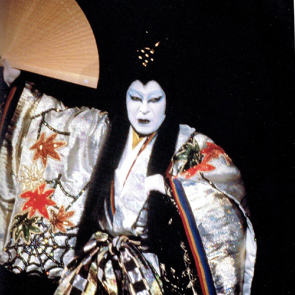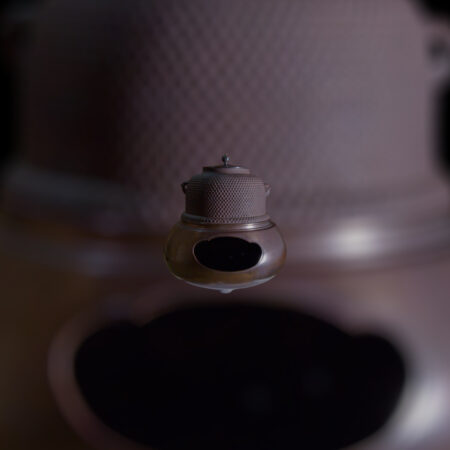A yuzen-dyed uchikake kimono made for a fashion show in 2005 with motifs associated with all Japanese New Year traditions you can think of-hacky sack, mirror rice cake, long-hanging Shime-kazari (a decoration
with a sacred straw rope), Kadomatsu (“gate pine”; a traditional Japanese New Year decoration made from bamboo and pine), Hagoita (a wooden paddle with beautiful paints on one side), Hane (to be paired up with
"hagoita" in the traditional game). The single piece of kimono tells all these long-lasting Japanese New Year traditions since the Edo period. This masterpiece is an utmost representation of the costumes for Oiran Agemaki (the highest-ranking courtesans in Japanese history) in the play
"Sukeroku Yukari no Edo Sakura", the signature play of Edo Kabuki with extraordinarily gorgeous costumes. Audience is, without a shadow of doubt, amazed by the fabulous appearance of the courtesan at the
hanamachi (a stage extension in Japanese kabuki theater). In the kabuki world, female roles are also played by male actors, and it's called "Onnagata”. “Agemaki” can only be played by the “Onnagata" actors in the highest grade. The play is about the top courtesan (“Oiran” in Yoshiwara, an official sex-oriented pleasure district recognized by the Edo shogunate. She is loved by the intelligent and cool-looking Sukeroku. In the Edo period, the district was a fashionable spot indeed. The kimono has appeared in a number of famous plays and fashion shows.
Art
A costume that dazzles audiences with its luxurious and brilliant design

Artist
Continuously transmitting the beauty of Japan on the global stage.
Yasuhiro Chiji
千地 泰弘
At the age of 22, he went to America with his father, a Buddhist art painter, and stayed for three years to paint a large mural of the Los Angeles Hompa Hongwanji Buddhist Temple. This experience is the starting point of his creative activities.
Later on, he encountered Kyoto yuzen dyeing (Kyoyuzen) and started his career as a yuzen artist.
He has created the costumes for the National Ballet of Belgium (Maurice Béjart) together with Issey Miyake and Tomio Mouri.
Since then, he has been designing and creating theater costumes, including those for kabuki plays. Taking on challenges both in the West and the East, he has been communicating the beauty of Japan on a global scale.

Art Style
Artisans, each honing their own skills, come together to create a single piece of fabric.
Yuzen Dyeing
Kimono is a long piece of fabric. Hand-drawn yuzen is a set of techniques for dye drawing designs on such long pieces of silk using brushes. The production process of hand-drawn yuzen consists of many steps, each done by artisans who have mastered and refined the techniques for the certain step. In this way, the production of a piece of hand-drawn yuzen cloth involves a number of steps and artisans.
From the design stage to the final dyeing stage, yuzen artist Yasuhiro Chiji gives directions for all steps of the production process.
As with sketching, the process starts from envisioning the entire design in your mind within the shape seen from the front. The design must be drawn in a three-dimensional manner. Chiji draws the entire design while envisioning the location of each design part when the cloth is worn as a kimono.
The first thing he does is to select the fabric. The appearance of the dyed design and expressions look dramatically different depending on which fabric is used. The next step is to design, followed by the creation of a full-size design. He then decides on which colors to use and then chooses which dyeing methods to use. Next is the dyeing process. Chiji and all the artisans involved must be of one mind in order to complete a yuzen-dye cloth that completely reproduces his design.

Roots
A traditional Japanese pattern dyeing technique.
Yuzen dyeing is a traditional Japanese design dyeing method. Yuzen dyeing, which expresses picturesque patterns on fabrics for kimono using a wide range of colors, developed during the Genroku period (1688–1704) of the Edo period when urban culture, known as the “townspeople culture,” was flourishing. Around this time, the folding fans drawn by Miyazaki Yuzensai, a Kyoto-based folding fan artist, gained popularity. Utilizing his designs in the field of design dyeing, the designs drawn by this popular folding fan artist were incorporated into kimono designs. This is the origin of yuzen dyeing. While Kyoyuzen made in Kyoto, Kagayuzen made in Kanazawa, and Edoyuzen made in Tokyo are called the three major yuzen, Kyoyuzen has the longest history. Colorful and gorgeous hand-drawn yuzen flourished the most during the Edo period (1603–1868) when urban culture thrived.
Kyoyuzen is characterized by a complete division of labor, with each step performed by artisans. The production of a piece of cloth for kimono involves a number of artisans skilled in each step. Kyoyuzen often features gorgeous designs including nature-based designs and traditional designs that were used for the official clothing of court nobles as well as furnishings, architectural interiors, etc. of their residences since the Heian period (794-1185). Generally decorated with embroidery, gold leaf, and silver leaf, Kyoyuzen is



特集記事一覧

Connecting People and Tradition through Dyeing

Exploring the Charms of Miyazu City, Kyoto Prefecture

A Hidden Gem of Otsuki City: Experience Guide to Enjoy with Mount Fuji

A Heartwarming Journey through a Treasure Trove of Nature and History

Experiencing History and Inherited Memories in Asuka Village

Discover! The Charm of Miki City

The Enchanting City of Morioka

Discovered! Exciting in Tokushima and Naruto City


